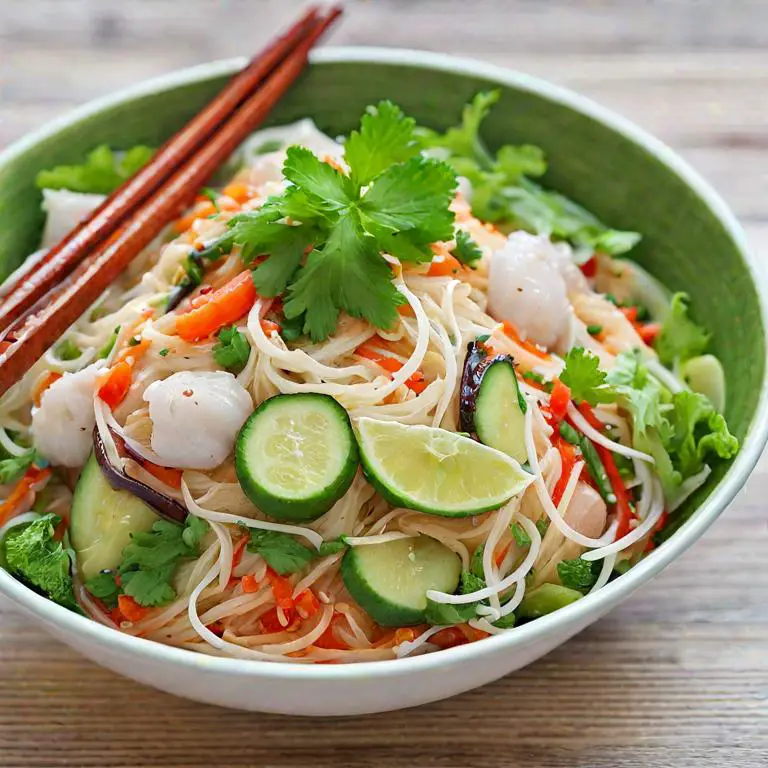In the vast and vibrant world of Asian cuisine, the Vermicelli Noodle Salad stands out as a testament to the art of combining simple ingredients to create a dish that is both light and deeply satisfying. This salad, with its roots in various Asian culinary traditions, is a colorful mosaic of textures and flavors, designed to refresh and invigorate the palate. It’s a dish that embodies the essence of summer but is equally delightful any time of the year. In this article, we’ll explore the intricacies of making an authentic Asian Vermicelli Noodle Salad, offering insights into the selection of ingredients, preparation techniques, and the secrets to achieving the perfect balance of flavors.
The Essence of Asian Vermicelli Noodle Salad
At its core, the Asian Vermicelli Noodle Salad is a celebration of freshness and harmony. It typically features thin rice noodles, an assortment of crisp vegetables, fresh herbs, a protein source such as grilled chicken, shrimp, or tofu, and is often crowned with a tangy, sweet, and savory dressing. The beauty of this salad lies in its versatility, allowing for endless variations that can cater to any taste or dietary preference.
Ingredients:
For the Salad:
- 8 ounces vermicelli rice noodles
- 1 cup thinly sliced cucumber
- 1 cup shredded carrots
- 1 cup thinly sliced bell pepper (any color)
- 1/2 cup thinly sliced red cabbage
- 1/4 cup chopped green onions
- 1/4 cup fresh cilantro leaves
- 1/4 cup fresh mint leaves
- 1/2 cup roasted peanuts, crushed (for garnish)
- Optional protein: grilled chicken, shrimp, or tofu
For the Dressing:
- 3 tablespoons fish sauce (or soy sauce for a vegetarian version)
- 2 tablespoons lime juice
- 1 tablespoon rice vinegar
- 2 tablespoons sugar
- 1 clove garlic, minced
- 1 red chili, finely chopped (adjust to taste)
- 2 tablespoons water
Instructions:
- Prepare the Noodles: Cook the vermicelli noodles according to the package instructions, usually by soaking in hot water for a few minutes until tender. Drain and rinse under cold water to stop the cooking process. Set aside to cool.
- Combine the Vegetables and Herbs: In a large bowl, mix together the cucumber, carrots, bell pepper, red cabbage, green onions, cilantro, and mint. If you’re adding a protein, ensure it’s cooked and sliced before adding it to the salad.
- Make the Dressing: In a small bowl, whisk together the fish sauce, lime juice, rice vinegar, sugar, minced garlic, chopped chili, and water until the sugar is fully dissolved. Taste and adjust the seasoning as needed.
- Assemble the Salad: Add the cooled noodles to the bowl with the vegetables and herbs. Pour the dressing over the salad and toss gently until everything is well coated.
- Garnish and Serve: Just before serving, sprinkle the crushed peanuts over the top of the salad for added crunch and flavor.
Tips for a Perfect Asian Vermicelli Noodle Salad
- Balance of Flavors: The key to a great Asian Vermicelli Noodle Salad is the balance of sweet, sour, salty, and spicy flavors in the dressing. Adjust the ingredients to suit your taste preferences.
- Texture Contrast: Aim for a variety of textures in your salad. The soft noodles, crunchy vegetables, and the optional addition of a protein create a satisfying mouthfeel.
- Freshness is Key: Use the freshest vegetables and herbs you can find. This salad is all about showcasing natural flavors and textures.
- Dressing the Salad: Dress the salad just before serving to prevent the noodles from becoming too soggy and the vegetables from losing their crispness.
- Customization: Feel free to customize the salad with your favorite vegetables, herbs, and proteins. This dish is incredibly adaptable and can be tailored to include what you love or need to use up in your fridge.
Conclusion
The Asian Vermicelli Noodle Salad is a dish that truly captures the spirit of Asian cuisine, with its emphasis on fresh ingredients, bold flavors, and contrasting textures. Whether you’re looking for a light lunch, a side dish for a summer barbecue, or a healthy addition to your meal rotation, this salad is sure to delight. Its simplicity, combined with the depth of flavor and variety of textures, makes it a perennial favorite. By following the steps outlined above and embracing the tips for achieving the perfect balance of flavors and textures, you can bring a taste of Asia into your home kitchen. Enjoy the process of creating this vibrant, nutritious, and utterly delicious salad, and don’t hesitate to make it your own.



